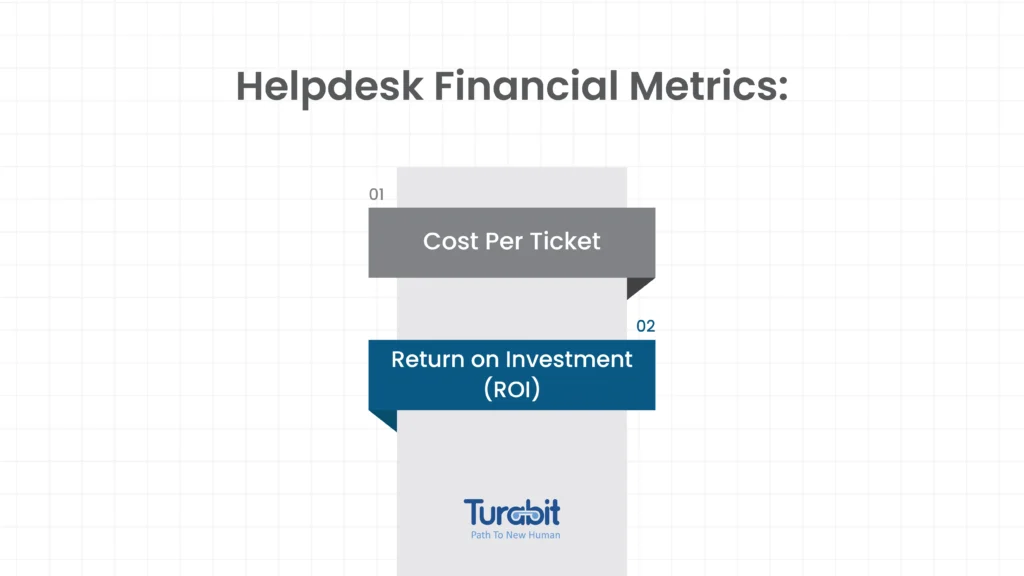In the world of IT support, numbers don’t lie, they tell a story of efficiency, performance, and, most importantly, financial health.
Metrics like Cost Per Ticket and Return on Investment (ROI) aren’t just fancy buzzwords; they are critical indicators that shed light on how effectively your resources are being utilized and whether your tech investments are paying off.
Think of them as the financial pulse of your IT operations, helping you understand where money is well spent and where it’s being drained.
In this article, we’ll break down these two key financial metrics, explore their importance, and show you how they can guide smarter business decisions.

1. Cost Per Ticket
Cost Per Ticket is a key metric that measures the average cost incurred by an organization to resolve a single IT support ticket. It plays a crucial role in assessing the financial impact of IT support operations and can be a valuable indicator of the effectiveness of processes, technology, and resource allocation.
Why Cost Per Ticket is Important?
Tracking Cost Per Ticket provides valuable insights into how much each support interaction costs. This allows organizations to better understand the financial efficiency of their IT support processes.
When monitored over time, this metric can reveal trends, helping businesses make informed decisions about investments in new tools, processes, or support strategies.
How Cost Per Ticket is Measured?
To calculate Cost Per Ticket, organizations should track all associated costs (such as personnel, tools, training, and overhead) related to the support team.
Then, divide these costs by the total number of tickets resolved in a specific time period.
Formula for Cost Per Ticket: Cost Per Ticket = Total Support Costs / Number of Tickets Resolved
For example, if the total cost of your support operations for a month is $10,000 and you resolve 500 tickets, your Cost Per Ticket would be: $10,000 ÷ 500 = $20 per ticket
Interpreting Cost Per Ticket:
A high Cost Per Ticket may signal inefficiencies in the support process, while a low figure suggests the organization is operating efficiently.
However, too much focus on reducing cost can sometimes compromise service quality, so it’s important to balance this metric with others like Customer Satisfaction or First Contact Resolution.
Best Practices for Using Cost Per Ticket:
By tracking and optimizing Cost Per Ticket, businesses can improve both their financial and operational performance in IT support.
2. Return on Investment (ROI)
Return on Investment (ROI) is a widely used metric that evaluates the efficiency of an investment. Organizations calculate ROI to determine whether the money spent on IT infrastructure, software, or other technology-related initiatives has provided adequate financial returns.
Why ROI is Important?
ROI serves as a key metric for assessing the success of investments and determining whether they are worth the financial commitment. High ROI indicates a profitable investment, while low ROI may suggest that the investment did not generate sufficient returns or value.
How ROI is Measured?
To measure ROI, you compare the gain or return from an investment to its initial cost. This comparison helps organizations understand the financial benefits relative to the resources spent.
Formula for ROI: ROI = (Gain from Investment – Cost of Investment) / Cost of Investment x 100
For example: If an organization invests $10,000 in a new IT system and the return generated is $15,000, the ROI would be: ROI = ($15,000 – $10,000) / $10,000 x 100 = 50%
Interpreting ROI:
Best Practices for Using Cost Per Ticket:
By calculating ROI, organizations can make more informed decisions, allocate resources efficiently, and maximize the value of their technology investments.
All in all
When it comes to managing IT support operations, financial metrics like Cost Per Ticket and Return on Investment are more than just numbers on a spreadsheet, they’re powerful tools for strategic decision-making.
By closely monitoring these metrics, organizations can strike the perfect balance between cost-efficiency and service quality, ensuring every dollar spent contributes to improved customer satisfaction and long-term growth.
Remember, it’s not just about spending less; it’s about spending smarter. So, keep an eye on those numbers, make data-driven choices, and watch your IT operations thrive.
Related read: 15 Key Help Desk Metrics to Track IT Support Performance

